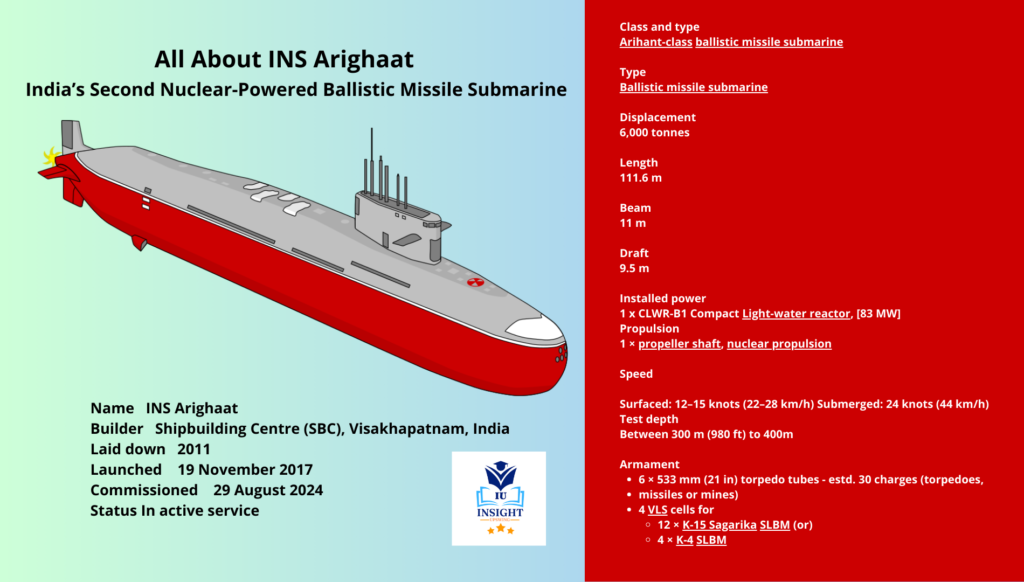India’s Strategic Leap: INS Arighaat Joins the Fleet
The Indian Navy brought INS Arighaat, its second nuclear-powered ballistic missile submarine, into service this week, marking a significant development for India’s nuclear deterrence. Defence Minister Rajnath Singh attended the induction ceremony in Visakhapatnam, Andhra Pradesh, emphasizing how this acquisition bolsters India’s nuclear triad and deterrence capabilities. Part of the Arihant-class submarines (called after the Sanskrit term that translates to ‘Destroyer of the Enemy’), the INS Arighaat is more sophisticated than its predecessor.
Understanding SSBNs: The Backbone of Nuclear Deterrence
As an essential part of a country’s nuclear deterrence, an SSBN (Ship, Submersible, Ballistic, Nuclear), also known as a nuclear-powered ballistic missile submarine, is a vessel outfitted to deploy submarine-launched ballistic missiles (SLBMs) bearing nuclear warheads. The INS Arihant, the first vessel in the Arihant class of indigenous nuclear submarines, is upgraded to become the INS Arighaat. It will be in addition to the 2009-commissioned INS Arihant. In 2017, INS Arighat’s construction began at Visakhapatnam’s Ship Building Centre (SBC).
INS Arighaat: A Closer Look at Its Capabilities
As per the brief, the submarine can reach a top speed of up to 24 knots (44 km/h) when submerged and 12–15 knots (22–28 km/h) when operating on the surface. Its hump has four launch tubes that let it carry twelve K-15 SLBMs with a range of about 750 kilometers or four nuclear-capable K-4 SLBMs with a range surpassing 3,500 kilometers. The submarine will be fitted out with torpedoes, and the K-15 missiles can carry key nuclear warheads. The 83 MW pressurized water reactors that power INS Arihant and INS Arighaat enable them to stay underwater for long periods. With the Arihant class, India’s underwater capabilities have come a long way. Arihant means “Destroyer of the Enemy” in Sanskrit.

The Role of SSNs in Modern Naval Warfare
The main aims of nuclear assault submarines (SSNs) are information gathering, anti-surface ship warfare, and anti-submarine warfare. These ships do not carry ballistic missiles; in place of that, they are fitted out with torpedoes and now and then cruise missiles. Their primary missions include detecting and attacking enemy surface ships and submarines, as well as supporting ground operations with cruise missile precision strikes. SSNs (Ship Submersible Nuclear) are designed to be faster and more maneuverable. They are often smaller and more nimble.
They can be propelled by nuclear reactors or traditional diesel-electric systems, which gives them versatility and the ability to carry out a variety of tasks, such as support for special operations and reconnaissance. On the other hand, SLBMs are launched from vertical launch systems by SSBNs, which are bigger. They place a strong focus on survival and stealth to stay hidden while on patrol and increase their deterrent power.
India’s Project 75 Alpha: The Future of Nuclear Attack Submarines
India has accepted plans to build six SSNs under Project 75 Alpha, which was approved by the Cabinet Committee on Security in February 2015. These submarines will be constructed at the Shipbuilding Center in Visakhapatnam and are anticipated to weigh about 6,000 tons. With almost all of the design work finished the first submarine should be put into service by 2032. Phase one of the SSN plan will see the development of the first three submarines, with phases two and three to follow. Subsequent designs might integrate cutting-edge technologies, which could enable submarines to carry more than 8,000 tonnes of cargo when necessary.
INS Chakra III: Enhancing India’s Submarine Strength
In addition to developing internally, India intends to lease INS Chakra III, a second Akula-class submarine that Russia is projected to deliver by 2025. This will function as a stopgap measure while the native SSNs are being created. The Akula-class submarine INS Chakra II, which India leased from Russia in 2012 for a decade, was previously in operation. The lease on this submarine expired in 2021, and it was decommissioned. Another submarine the Akula-class is likely to join the Indian Navy by 2025. A $3 billion agreement with Russia has been signed by India for its lease. The aim of this new submarine, which will succeed INS Chakra II, is to significantly improve India’s undersea capabilities.
The stealth and cutting-edge technology of the Akula-class submarines are well recognized for enabling them to operate for extended periods without being noticed. Their versatility allows them to do intelligence missions and hunt down hostile submarines. It is believed that the addition of a second Akula-class submarine to India’s fleet will strengthen its naval might and improve its ability to deter other nations in the Indian Ocean Region (IOR). And, it will be an invaluable training ground for Indian personnel, with a focus on nuclear submarine operation and maintenance—a critical skill for India’s continued development of SSNs under Project 75 Alpha.
Strengthening the Nuclear Triad: INS Arighaat’s Strategic Importance
India at present owns two SSBNs, INS Arihant (S-2) and INS Arighaat, which give it vast strategic leverage and discourage any navy trying to establish the upper hand in the Indo-Pacific. India’s nuclear triad and second-strike capacity, which pick up its no-first-use policy, depend heavily on these submarines. India even now has air-launched nuclear capacity in addition to land-based nuclear missiles like the Agni series. SSBNs are expected to be the most powerful of India’s three nuclear weapons.
As part of its long-term submarine acquisition and capability development plan, the Center intends to build both nuclear and conventional submarines. India intends to create six nuclear attack submarines to be built in three blocks and five Arihant-class vessels. According to multiple media reports, India’s fourth SSBN, codenamed S-4, is expected to launch shortly after the country’s third SSBN, INS Aridaman, or S4.
